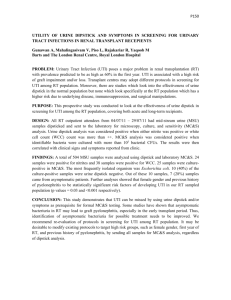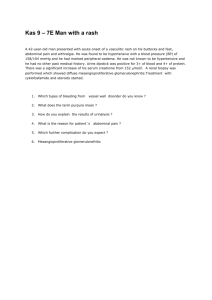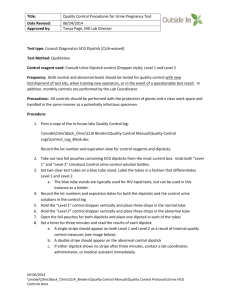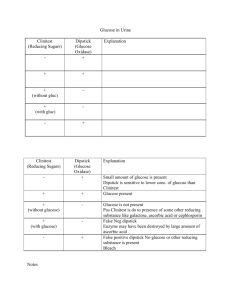He Recovery Using Single Shot Cryopump 3 July 25
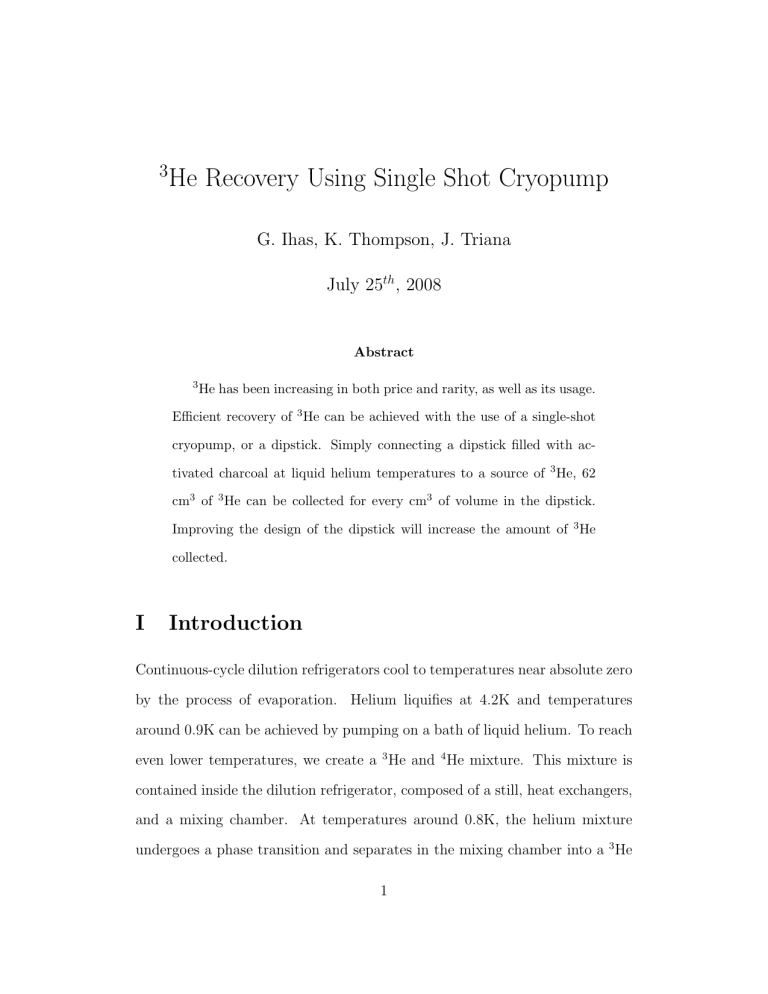
3
He Recovery Using Single Shot Cryopump
G. Ihas, K. Thompson, J. Triana
July 25 th , 2008
Abstract
3
He has been increasing in both price and rarity, as well as its usage.
Efficient recovery of 3 He can be achieved with the use of a single-shot cryopump, or a dipstick. Simply connecting a dipstick filled with activated charcoal at liquid helium temperatures to a source of
3
He, 62 cm 3 of 3 He can be collected for every cm 3 of volume in the dipstick.
Improving the design of the dipstick will increase the amount of
3
He collected.
I Introduction
Continuous-cycle dilution refrigerators cool to temperatures near absolute zero by the process of evaporation. Helium liquifies at 4 .
2K and temperatures around 0 .
9K can be achieved by pumping on a bath of liquid helium. To reach even lower temperatures, we create a 3 He and 4 He mixture. This mixture is contained inside the dilution refrigerator, composed of a still, heat exchangers, and a mixing chamber. At temperatures around 0 .
8K, the helium mixture undergoes a phase transition and separates in the mixing chamber into a
3
He
1
rich phase and a 3 He poor phase.
3 He will evaporate from the 3 He rich phase into the 3 He poor phase, provided that an equilibrium between the two states has not been achieved. Pumping on the poor phase of the mixture will allow the dilution refrigerator to continue cooling to temperatures as low as 2mK.
When the helium mixture is pumped out of the mixing chamber, 3 He evaporates preferentially in the still, leaving
3
He the only gas that enters the pump.
The majority of the helium is contained in the pipes and inner workings of the dilution refrigerator where it can be sealed off from the surroundings. However, when the vacuum pump is turned off, the 3 He that was contained in the pump is in danger of dispersing into the surrounding environment where it cannot be recovered.
3
He is a rare isotope of helium, and it makes up 1 .
37 × 10
− 6 of all naturally occuring helium. The main source of
3
He is as follows [2]:
6
Li +
1 n → 3
H +
4
He
3
H
12 .
5yrs
→
3
He +
−
β
(1)
(2)
These reactions occur mainly in the warhead of thermonuclear devices, and
3 He is gathered from these devices to be kept in cannisters for future use. As a result,
3
He is expensive. Due to the rising costs of helium, it has become increasingly important to develop efficient ways of recovering it from various experimental apparati. A simple, yet efficient method of recovering helium is through a cryopump. Since the helium to be recovered is inside the vacuum pump, a single shot cryopump is prefered over a continuous cryopump. A single-shot cryopump is also referred to as a dipstick. Ideally, the dipstick
2
should have a direct connection to the vacuum pump, and then it should have the ability to be removed so the 3 He may be refined and reused.
II Background
The dipstick to be used works by the process of physical adsorption . Coconut shell activated charcoal is the adsorbing material inside a dipstick. Activated charcoal has a surface area on the order of 1000 m 2 /g [3]; this high surface area allows small atoms, such as 3 He, to be trapped. Physical adsorption is also a statistical property dependant upon the speed of the particle and the mass of the particle. The slower the particle is, the more likely it will be trapped.
The mass of
3
He is not a variable, but the speed of
3
He is. To slow the atoms down, we must lower the temperature of the atoms. Immersing the dipstick in a low temperature bath would be the ideal solution to cooling the dipstick, and liquid helium is readily available for use at the University of Florida.
III Experimental Design
To cool the dipstick to liquid-helium temperatures, we insert the dipstick into a liquid-helium storage dewar. A dewar is a thermally isolated container used for cryogenic fluids. The aperature of the dewar is 0 .
5
00
, which will be the outer diameter of the dipstick to maximize the volume. The dipstick is cylindrical in shape and has a conical shape on top to ease the ascent out of the dewar.
Since we are dealing with cryogenic fluids, the material of choice for the dipstick is stainless steel, which is a standard material for cryogenic applications due to its strength and ease of welding. The maximum fill level for the stor-
3
age dewars at the University of Florida is about 22
00
, so the maximum height of the dipstick cannot exceed this level because the entire dipstick should be submerged in liquid helium for it to work efficiently.
The inner diameter of the dipstick is determined by the ASME Boiler and
Pressure Vessel Code, Section VIII (1983)[1]. The code gives an equation for the minimum thickness of a cylindrical vessel, like our dipstick, based on its design pressure. If we assume that we are going to collect no more than 5L of gaseous 3 He at 1 / 6 atm into our dipstick, we can use the Ideal Gas Law and
Boyle’s Law to calculate the minimum thickness of our dipstick. One of the standard stainless steel pipe thicknesses is 0 .
065
00
, which is thicker than the minimum thickness calculated, making it a suitable size for our dipstick.
Since our dipstick will be operating in pressure regions over 500 psi, all our joints need to be hard soldered or welded. The design of the dipstick needs to incorporate beveled edges near the joints to allow for the excess metal required in welding to have a strong joint that can withstand the high pressure.
Since the dipstick has to be lowered into and raised out of the dewar, a flexible tube needs to connect it to the plumbing of the dilution refrigerator that leads to the pump. There exists a high pressure capillary tubing that is rated for pressures of 15,000psi and is flexible enough to suit our purposes. This tubing, made of stainless steel, also fits our guidelines for cryogenic fluids. A stopper, preferably polystyrene, of approxiamely the same diameter of the dipstick should be inserted onto the high pressure capillary tubing. The stopper will keep the dewar sealed from the surroundings while the dipstick is sub-
4
merged.
The dipstick needs to have a valve attached to it so we can disconnect it from the plumbing and reconnect it elsewhere for processing of the 3 He. We will use a high-pressure valve with Swagelok fittings, because it is a reliable valve and constructed of stainless steel. A pressure gauge should also be connected to the dipstick so we can get measurements of how much
3
He was collected and how much is in the dipstick when it is disconnected. The gauge will need to register pressures of over 1000psi.
Since the purpose of our dipstick is to collect 3 He out of the pump when it is not in use, we need to make sure the 3 He passes through a series of filters to ensure that unwanted substances do not accumulate in the dipstick. On continuous-cycle dilution refrigerators, the helium mixture passes through a series of filters and traps before going back to the mixing chamber. We utilize these existing filters and route the helium gas from the pump to pass through them before entering the dipstick.
The dipstick will be operating at a high pressure and could create a safety hazard. The pressure on the gauge should be closely monitored while the dipstick is in use. When the dipstick warms to room temperature, the pressure should rise significantly. The maximum safe working load of our dipstick is
3000psi, and should that pressure be exceeded, we will need to vent the 3 He back into the pump or into a separate tank. Since the integrity of the dipstick can be compromised if it is damaged, a cushioned container should be made to house the dipstick when not in use. A large-diameter pipe filled with foam
5
is sufficient for this purpose.
For a dipstick to work properly, it must be packed with activated charcoal.
First, we put a filter between the charcoal and the capilary tubing to keep the charcoal from migrating into the plumbing and causing blocks in the pipes.
We use copper felt since it is porous enough to allow the
3
He gas through, but dense enough to block the charcoal. Then we pack the charcoal in the dipstick until it is about half an inch from the top so we still have room to weld the rest of the dipstick together. We use 14-mesh coconut shell activated charcoal because it is the common type and size of activated charcoal used for adsorption purposes.
IV Methodology
We built the dipstick to best suit our purposes of collecting 3 He from the vacuum pump. The exact specifications of our dipstick are listed in Table 1.
Before putting the dipstick into use, we need to leak check it. If the dipstick has a leak, the liquid-helium dewar can be contaminated and we could lose the
3
He to the environment. When the dipstick is first welded, we bubble test it to check for major leaks. Once the dipstick passes that test, we can move on to using the mass spectrometer sensitive to 4 He. This apparatus creates a high vacuum with a turbomolecular pump connected to a mass spectrometer.
To find leaks, we spray helium gas on all the joints, and if there is a leak, it will be detected by the mass spectrometer. Once the dipstick passes that test, we consider it to be leak tight. Now we must evacuate the dipstick and purge the activated charcoal of unwanted substances. We do this by pumping
6
on the dipstick and heating it up with a heat gun. The heat causes any gases trapped by the charcoal to be released and the pump removes the gases from the dipstick. The dipstick is now ready for use.
Table 1: Dipstick Specifications
Material Length Diameter Wall Thickness
316 SS 15” 0.5” 0.065”
We insert the room-temperature dipstick into the liquid-helium dewar and cap off the dewar with the stopper. The liquid-helium level in the dewar is 18
00
, which is enough to submerge our dipstick. We reroute the plumbing lines so the 3 He gas will pass from the pump, through the filters, and into the dipstick.
We allow the dipstick to cool for approximately two hours, at which time we raise the dipstick out of the dewar and place it into an empty dewar while it warms to room temperature. The 3 He gas that is trapped by the charcoal expands and causes the pressure to rise to 750psi. We transfer the gas into a separate tank and repeat the process, but we are going to leave the dipstick in the dewar overnight so it can capture more
3
He. In the morning, we take the dipstick out of the dewar to warm back up to room temperature; the pressure this time rises to 250psi.
V Results
Our data correspond to collecting the equivalent of 1 .
65L at standard temperature and pressure. We collected less than the amount of 3 He that we estimated, but our estimation was based on the maximum capacity of the vacuum and the plumbing connected to the vacuum. The dipstick did not create a strong vacuum like we expected and it also took many hours to collect the
3
He gas.
7
There may be several reasons for these limitations, and we will address them in our next dipstick design.
The impedance of the copper felt may be enough to affect the time it takes for the dipstick to create a strong vacuum and to affect the overall strength of the vacuum. To account for this problem in future designs, we will use copper wool to keep the charcoal from migrating into the plumbing. The impedance of the copper wool is neglegible and allows us to maximize the usable volume of the dipstick.
The packing geometry of the charcoal can also be of some problem to the overall preformance of the dipstick. In our current design, the 3 He has to diffuse through the charcoal from the top down, which is an inefficient route for the
3
He to travel. We would like to maximize the accessible surface area so the
3
He can diffuse faster through the charcoal. One solution is to have a slotted pipe go through the middle of the charcoal, allowing the 3 He to diffuse radially. However, the size of the slotted pipe will take up more volume and allow us to collect less 3 He.
Finally, the long collection time may be due to the adsorption process locally heating the charcoal, causing slight outgassing. The slight outgassing is counterproductive to our design, and although the adsorption process will continue until completion, the duration of the collection will be much longer than anticipated. To alleviate this problem, we will incorporate fine copper wool into the activated charcoal within the dipstick. The copper is an excellent conductor of heat and will lessen the outgassing effects, leading to a shorter
8
collection time.
VI Conclusion
Our current dipstick collected a large percentage of the available 3 He in a reasonable amount of time. Our experiments allowed us to develop multiple methods of collecting 3 He while using existing experimental apparati that were readily available. Our design can be used multiple times and is inexpensive.
VII Acknowledgments
We would like to thank the UF Cryogenic Engineering Department for allowing us to use their liquid-helium dewars for our experiment. We would also like to thank the UF Physics Department Machine Shop for working with us to design, build, and weld the dipstick. We would finally like to thank the NSF,
Kristin Nicola, and Kevin Ingersent for sponsoring the REU program here at
UF, and acknowledge the NSF grant # DMR-0602778.
References
[1] T.M. Flynn, Cryogenic Engineering (Marcel Dekker, New York, 1997).
[2] O.V. Lounasmaa, Experimental Principles and Methods Below 1K
(Academic Press, New York, 1974).
[3] M. Yalcin and A. Arol, ”Gold Cyanide Adsorption Characteristics of Activated Carbon of Non-coconut Shell Origin,” Hydrometallurgy, 63 , 201-206
(2002).
9

